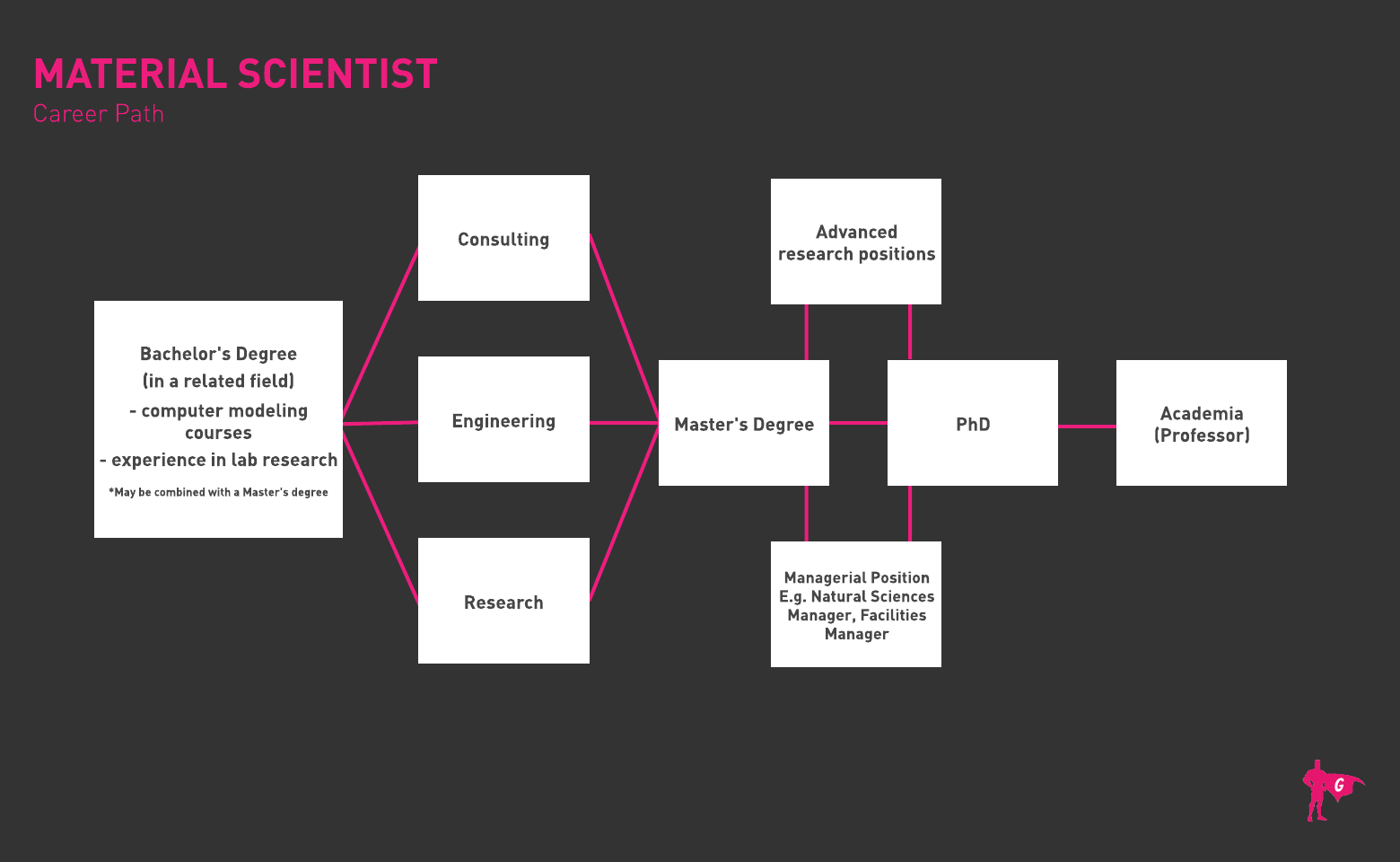Focos de atención
- Polymer Materials Consultant
- Research and Development Scientist (R and D Scientist)
- Investigador científico
- Glass Scientist
- Ceramic Scientist
- Metallurgical Scientist
- Polymer Scientist
- Composites Engineer
- Biomaterials Scientist
- Nanomaterials Scientist
Materials scientists study the structures and chemical properties of natural or synthetic materials (e.g. metals, rubber, ceramics, glass, etc.) in order to determine the quality of manufactured products, improve products and develop new products. These tasks may involve strengthening or combining materials to improve their efficacy.
- Satisfaction from being involved in a project from its conception to the final outcome
- Working with, and learning from, other professionals from a variety of fields (e.g. engineers and processing specialists)
- Intellectual stimulation
Investigación
- Basic research: plan and execute research on the structures, composition and properties of materials (e.g. metals, ceramics, alloys, lubricants and polymers)
- Applied research: use information obtained from basic research to develop new products or improve existing ones
- Record detailed notes throughout the research process
Experiment
- Use computer modeling to study the response of various materials to applied forces or other treatments
- Conduct tests on materials to ensure they meet safety and quality standards
- Determine the efficacy of combined materials or newly developed materials when used in products and applications
Report
- Prepare technical and detailed reports that indicate methods and findings, to be used by other scientists, sponsors, and/or customers
- May also have to verbally/visually present findings to other scientists
Habilidades blandas
- Pensamiento crítico
- Razonamiento deductivo
- Comunicación escrita y oral
- Organization/Time-management
Habilidades duras
- Física
- Química
- Engineering and Technology
- Matemáticas
Habilidades técnicas
- Computer modeling software
- Analytical/Scientific software (e.g. SPSS)
- Spreadsheet software (e.g. Excel)
- Industrial manufacturing company
- Gobierno
- Academia (Universities/Colleges)
- Research and development for companies engaged with the physical, engineering, and life sciences
Dedicating a lot of time to studying and training
- 3D printing with more than plastic (e.g. glass, ceramic)
- New materials for consumer electronics (e.g. constructing smartphones with ceramics and glass)
Requisitos básicos
- Bachelor’s Degree in a related field (e.g. Chemistry, Materials Science, Materials Engineering) for entry-level jobs.
- Requisite courses for attaining skills in computer modeling, which is heavily relied upon in research and development programs. Also courses in organic, inorganic, and physical chemistry, along with plenty of math, physics, biological sciences, computer science, and labs.
- O*Net reports that 38% of Material Scientists have a bachelor’s, 24% a master’s, and 24% a PhD
- College programs should ideally be accredited by the American Chemical Society
- Many employers will provide new employees with on-the-job training specific to their function within the organization
- Lab work is often done via internships, cooperative programs, or work-study experiences
Tips
- Some fast-tracked programs offer a combined bachelor’s/master’s in Chemistry, and accelerated 4+1 BS/Master’s dual degree programs.
- Some Chemistry programs offer a specialization in Materials Science
Promoción profesional
- Master’s Degree or PhD in a related field for research positions
- Graduate courses may include subfield topics like medicinal chemistry
- Additional certifications include:
- Society of Tribologists and Lubrication Engineers - Certified Lubrication Specialist
- The Association for Materials Protection and Performance - Corrosion Specialist and Protective Coatings Specialist
- World Safety Organization - WSO Certified Hazardous Materials Supervisor
- In high school, load up on advanced classes in chemistry, math, and computer science to prepare for college
- In college, gain experience in lab research through internships, fellowships, or work-study programs
- Map out your career goals to determine if you’ll want or need a graduate degree
- Decide if you want to do an accelerated dual degree bachelor’s/master’s
- Determine which learning method works better for you — in-person, online, or hybrid. Some students may opt to do their undergrad degree in person and their master’s online
- Work with your academic advisors on appropriate electives to bolster your major
- Figure out what you want to specialize in, such as ceramics, glasses, metals, nanomaterials, polymers, and semiconductors
- Join professional organizations such as the American Chemical Society to network, stay engaged, and discover opportunities
- Keep up with industry trends by reading the Journal of Materials Science, Materials Today, and other relevant publications

- College summer/semester internships allow for networking within a company: Build connections during these internships to gain references and potentially roll into a full-time position after graduation
- Networking is also facilitated through college/university activities and events. Work with your school’s career center to find jobs, polish your resume, and practice interviewing.
- LinkedIn: Los posibles empleadores ven tu perfil, así que asegúrate de que esté actualizado y refleje eficazmente tus habilidades y logros. Asegúrate también de revisar tus mensajes con regularidad.
- Online applications- typically through job search engines, e.g. Monster (type up your info, attach a PDF of your resumé, and send it off)
- Old-school method: get in your car, and drive up to the office with a copy of your resumé. Keep appearing at the office if that is what it takes. This is also the best way to see the work environment and what you’ll be doing, to determine if you really want to work at that location
- Consider where Materials Scientists are employed! 25% of workers are employed in R&D, 15% in chemical manufacturing, 14% in company management, 10% in computer/electronic product manufacturing, and 7% in architectural, engineering, or related services
- Move to where the jobs are! The Bureau of Labor Statistics notes that the highest concentration of jobs for Materials Scientists are in Delaware, New Hampshire, Washington, Maryland, and Iowa. The states with the highest employment levels are New York, California, Illinois, Pennsylvania, and Washington
- BLS also notes that Materials Scientists will be increasingly needed to help in the energy and transportation sectors, and in the electronics industries
- Review Materials Scientist resume templates for ideas
- Asegúrate de que tu currículum es impactante, convincente, sin errores y contiene muchas estadísticas y detalles.
- Look for opportunities on Indeed, Glassdoor, and other job portals. Advertise your availability on LinkedIn, too
- Pregunte previamente a sus posibles referencias antes de facilitar sus datos de contacto.
- Review Materials Scientist common interview questions like “How do you determine the best combination of materials for a particular project?” Think about how you’d answer the tough questions!
- Practice mock interviews so you can present yourself as well-prepared and confident
- Go over the applicable terminology for materials science
- Being detail-oriented
- Capacidad para trabajar de forma independiente
- High degree of mental focus
- Natural aptitude in science and statistics
Páginas web
- The Materials Research Society
- The Materials Information Society
- Materials Today
- Asociación Americana para el Avance de la Ciencia
- Sociedad Americana de Química
- American Chemical Society Committee on Professional Training
- American Chemical Society Green Chemistry Institute
- American Chemistry Council
- Instituto Americano de Ingenieros Químicos
- American Physical Society
- American Vacuum Society
- ASM International
- IEEE
- Journal of Materials Science
- Sociedad de Investigación de Materiales
- Materials Today
- National Resource Center for Materials Technology Education
- Materials Witness
- Watch a Materials Scientist in action
Libros
- Mechanics of Materials, by Russell Hibbeler
- Concepts of Materials Science, by Adrian P. Sutton
- Materials Selection in Mechanical Design, by Michael F. Ashby
Apart from research, professionals trained in materials science may work in materials/chemical engineering or education
Newsfeed

Trabajos destacados

Cursos y herramientas en línea

Expectativas salariales anuales
New workers start around $110K. Median pay is $138K per year. Highly experienced workers can earn around $176K.





